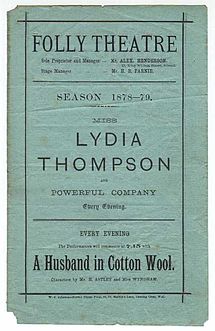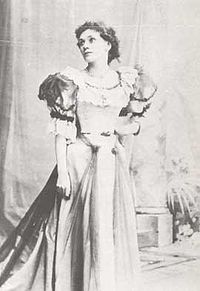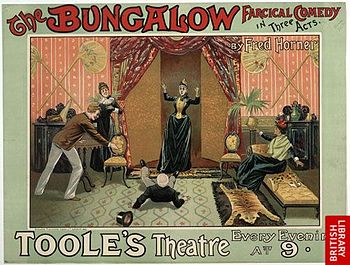- Folly Theatre
-
- This article is about the former theatre in London, named, for a time, the Charing Cross Theatre. For the nearby music hall of the same name see Charing Cross Music Hall. For theatre of the same name in Kansas City see Folly Theater
Coordinates: 51°30′27″N 0°07′23″W / 51.507466°N 0.122981°W
Folly Theatre 
Folly Theatre, programme from 1878–79 seasonAddress William IV Street City Westminster, London Designation Demolished Architect Bradwell and Field Owned by John Lawrence Toole Capacity 900 Type Music hall and playhouse Years active 1869 - 1895 Rebuilt 1869 Arthur Evers
1876 Thomas Verity
1882 J. J. ThompsonPrevious names 1840 Lowther Rooms
1848 The London Oratory
1858 Polygraphic Hall
1869 Charing Cross Theatre
1876 Folly Theatre
1882 Toole's TheatreCurrent use Police station (on site) The Folly Theatre was a London theatre of the late 19th century, in William IV Street, near Charing Cross, in the City of Westminster. It was converted from the house of a religious order, and became a small theatre, with a capacity of 900 seated and standing. The theatre specialised in presenting music hall, burlesque and opera bouffe. The Beefsteak Club had quarters above the theatre.
As a stock company, under the direction first of Alexander Henderson and Lydia Thompson and then of John Lawrence Toole, the theatre was significant for beginning the professional careers of many Victorian era actors, writers and actor-managers. The theatre was demolished in 1895, possibly due to disturbance caused to the neighbouring Charing Cross Hospital.
Contents
History
Early years
The building opened as the Lowther Rooms[1] in 1840. It was the residence of the Fathers of the London Oratory of St. Philip Neri from 1848–56 and was used for lectures. Here, in 1850, John Henry Newman delivered his Lectures on Anglican Difficulties, after his conversion to Catholicism.[2] On the departure of the religious order, which moved to the Brompton Oratory, the hall became Woodin's Polygraphic Hall in 1855, where William S. Woodin gave monologue entertainments.[3]
In 1869, the building was converted to a small Music hall and playhouse called the Royal Charing Cross Theatre and, in 1872 was renamed the Charing Cross Theatre and was advertised as the Theatre Royal, Charing Cross, in 1874-75.[4] The theatre opened on 19 June 1869 with W. S. Gilbert's burlesque of Norma, called The Pretty Druidess, on the bill,[5] and in 1870 it held Gilbert and Frederic Clay's The Gentleman in Black. In 1872, it hosted J. S. Clarke's revival of Sheridan's The Rivals, featuring Mrs Stirling in the role that was to make her famous as Mrs Malaprop.[6] The name Charing Cross Music Hall was also adopted in the late 1880s by the brothers Carlo and Giovanni Gatti for their Gatti's-Under-the-Arches Music hall. This became the Hungerford Music Hall in 1883, later returning to the former name.[7]
Folly Theatre
After some rebuilding, by architect Thomas Verity, the theatre was renamed The Folly Theatre in 1876, when it was bought by Alexander Henderson, and it became a burlesque house, with his wife, Lydia Thompson, in the lead roles. The first piece was a successful burlesque of Blue Beard.[8] In 1877, Up the River, or the Strict Kew-Tea, by H. B. Farnie and Robert Reece played at the theatre[9] as did a Farnie and Reece adaptation of Offenbach called The Creole.[10]
In 1878, the theatre had a tremendous success with Violet Cameron in Robert Planquette's Les cloches de Corneville, adapted by Farnie and Reece, which (after transferring to the Globe Theatre and returning to the Folly), held the record for long runs in musical theatre for a decade. Florence St. John got her start in the piece on tour and then in the theatre. Farnie and Reece's burlesque Stars and Garters then played. Reece's successful burlesque, Carmen; or Sold for a Song, and Sydney Grundy's After Long Years both played at the theatre in 1879. T. W. Roberton's Dublin Bay played here in 1880.[10] The theatre was described in Dickens Dictionary of London (1879) as A little bandbox of a place, very prettily fitted up, and with a decided speciality for burlesque and opera bouffe.[11]
On 7 November 1879, John Lawrence Toole (1830-1906) took over the management, with a stock company. Presentations included farces, burlesques and travesties of popular plays, beginning with H. J. Byron's A Fool and His Money.[12] Toole's only son, Frank, died on 7 December 1879 following an earlier football injury from which he never fully recovered.[13] Toole was both a noted comedian and a friend of Charles Dickens. He spent much of the next few years touring, but also produced plays at the theatre, including Arthur Wing Pinero's Hester's Mystery (1880) and Byron's Upper Crust and Auntie (1880),[14] Dion Boucicault's play, Dot, starring Toole, was produced here in 1881.[15]
Toole's Theatre
In 1882, after further rebuilding, Toole re-opened the theatre as Toole's Theatre, becoming the first actor to have a West End theatre named after him.[16] Noted actress Florence Farr (1860-1917) began her professional career with an apprenticeship at Toole's theatre, débuting with a juvenile role in Byron's Uncle Dick's Darling, in 1882.[17] In 1883, Stage Dora; or, Who Killed Cock Robin, a burlesque by F. C. Burnand of Sardou's Fédora, premiered at Toole's, starring Toole. Burnand's Paw Claudian (1884) was a burlesque of the 1883 costume (Byzantine) drama 'Claudian' by Henry Herman and W. G. Wills. Mr. Guffin’s Elopement and The Great Tay-Kin, two shows with words by Arthur Law and music by George Grossmith, starring Toole, played at the theatre in 1885.[18] The last play by John Maddison Morton to be produced in his lifetime, a three-act farcical comedy called Going It, played at Toole's in 1885 and kept the house in a continual roar of laughter.[19] Pinero's Girls and Boys played here in 1885, as did Billee Taylor in 1886 and The Butler, by Herman Charles Merivale, starring Toole, also in 1886. Pepita, an operetta by Charles Lecocq, premiered at the theatre in 1888. The Don, by Merivale, also starred Toole in 1888.[10]
The Bungalow, by Fred Horner, played at the theatre in 1890.[20] Ibsen's Ghost, a one-act parody on Ghosts, starring Irene Vanbrugh and Toole, was J. M. Barrie's first London play, running for just 27 performances at Toole's Theatre from 30 May 1891. In 1892, Toole directed the première of Barrie's first hit play, Walker, London, which ran for 497 performances.[21]
Toole retired in 1893, due to increasing ill health, brought on by the deaths within a few years of his family. His last piece was Thoroughbred by Ralph Lumley, and upon his retirement Rutland Barrington replaced him in the role.[22] The theatre was taken over by Violet Melnotte, who had made her début at the Folly Theatre in October 1876 as Fezz in Bluebeard with Lydia Thompson's Company. She had many interests and at the same time was building the Duke of York's Theatre, with her husband Frank Wyatt.[23]
The lease expired in 1895 and plans were drawn up by C. J. Phipps to rebuild the theatre, but they were opposed, apparently because the noise at the theatre disturbed patients at the Charing Cross Hospital.[3] The theatre was demolished in 1896[24] and the site used to extend Charing Cross Hospital.[25] The site is now a part of the Charing Cross Police Station.
References
- ^ Named for the nearby popular Lowther Arcade, a covered market for fancy goods, some 250 feet long and considered at that time one of the sights of London in Charing Cross, the railway stations, and Old Hungerford Market, Old and New London: Volume 3 (1878), pp. 123-134 accessed: October 16, 2007
- ^ Certain Difficulties Felt by Anglicans in Catholic Teaching John Henry Newman accessed 11 Oct 2007
- ^ a b Toole's Theatre-Polygraphic Hall-Charing Cross Theatre-The Folly (Arthur Lloyd) accessed 11 Oct 2007
- ^ "Victorian London - Entertainment and Recreation" from VictorianLondon.org accessed 11 Oct 2007
- ^ Review of the theatre's opening night, The Times (republished at the Gilbert and Sullivan Archive)
- ^ Theatres in Victorian London Philip V. Allingham (The Victorian Web) accessed 11 Oct 2007
- ^ Advertisement for the Grand Star Company for Xmas at the Charing Cross Music Hall Collect Britain (British Library) accessed 11 Oct 2007
- ^ Gänzl, Kurt. Lydia Thompson, Queen of Burlesque (2002) Routledge ISBN 0415937663
- ^ Information from the Operetta Research Center accessed 11 Oct 2007
- ^ a b c Adams, William Davenport. A Dictionary of the Drama (1904) 1904 Chatto & Windus, London
- ^ Charles Dickens (Jr.), Dickens's Dictionary of London, 1879 accessed 11 Oct 2007
- ^ MacMichael, J. Holden. The Story of Charing Cross and Its Immediate Neighbourhood (1906) Chatto & Windus, accessed 12 October 2007
- ^ Culme, quoting The Sketch, 13 December 1879, accessed 12 October 2007
- ^ NY Times review of The Upper Crust and Auntie April 26 1880 accessed 11 Oct 2007
- ^ Information from the play's programme accessed 11 Oct 2007
- ^ Obituary: John Lawrence Toole, The Times, 31 July 1906, p. 5
- ^ Boisseau, Robin Jackson (2004-05-05). "The Women of the Abbey Theatre, 1879-1925". University of Maryland. https://drum.umd.edu/dspace/handle/1903/1530. Retrieved 2007-10-11.
- ^ Grossmith, George (1888). A Society Clown: Reminiscences. Bristol/London: Arrowsmith. Chapter 8 Available online here
- ^ Scott, Clement, "Biographical Introduction" to Morton, John Maddison, Plays for Home Performance. London: Ward, Lock and Co., 1889, p. xiv.
- ^ Notices and posters for Toole's Theatre pieces
- ^ Peter Pan exhibition site
- ^ Barrington, Rutland (1908). Rutland Barrington: A Record of 35 Years' Experience on the English Stage, By Himself, p. 100
- ^ Violet Melnotte (1855-1935) D'Oyly Carte, Who Was Who (Boise State University) accessed 11 Oct 2007
- ^ Earl, John and Michael Sell. Guide to British Theatres 1750-1950, pp. 250 (Theatres Trust, 2000) ISBN 0-7136-5688-3
- ^ Papers: Toole, John Lawrence (University of Rochester) accessed 11 Oct 2007
Categories:- Former theatres of London
- Former buildings and structures of Westminster
- Buildings and structures completed in 1840
- 1895 disestablishments
- Former music hall venues
- Charles J. Phipps buildings
Wikimedia Foundation. 2010.



